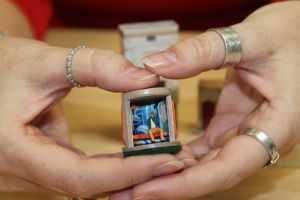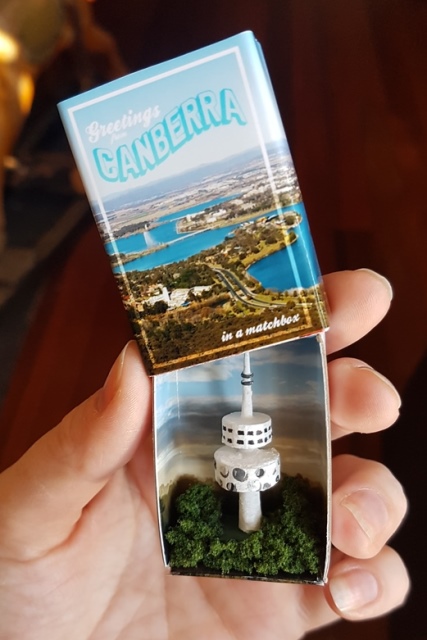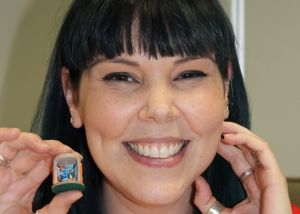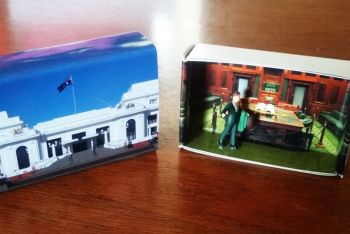
Where did the idea for matchbox miniatures and suitcase dollhouses come from?
My father is an architect, so I have always been interested in building. My partner has an archaeological background and is interested in history and I am an animator. I do stop motion animation and computer animations and I love miniatures. I love little things and I have very steady hands, almost surgeon hands from my stop motion days. It all kind of came together, when you put the miniatures with the love of buildings and the love of history.
 We do mainly Canberra and Queanbeyan buildings. We have a couple of houses that are studies as we find people really like studies. We also do special orders for people overseas. For example, I had someone order the Lincoln booth in the Ford Theatre in Washington where Lincoln was assassinated. She wanted it for her sons for Christmas, so I made 5 of those. They are big Civil War history buffs and she sent us photos. We even made sure we put the door on the back that John Wilkes Booth escaped out of.
We do mainly Canberra and Queanbeyan buildings. We have a couple of houses that are studies as we find people really like studies. We also do special orders for people overseas. For example, I had someone order the Lincoln booth in the Ford Theatre in Washington where Lincoln was assassinated. She wanted it for her sons for Christmas, so I made 5 of those. They are big Civil War history buffs and she sent us photos. We even made sure we put the door on the back that John Wilkes Booth escaped out of.
Mostly we do Canberra and Queanbeyan buildings because we love them. My dad being a heritage architect, I spent a lot of time in these buildings as a kid. People at Christmas time buy the miniatures as gifts for expats because they are so iconic.
People bag Canberra and I hate that. Visiting Canberra because you were on a school trip or visiting the public institutions is not enough to assess the city. I think Canberra is a beautiful city and a wonderful place to live. There’s so much here that people don’t know about. I’ve definitely felt a change in the city since the Centenary. There’s certainly been a lot more artists doing pro-Canberra work, such as the tea towel or the mugs with the bus shelter on them.
We are looking at doing something called ‘Canberra in a cube’ where we put all the miniatures into a box that folds out into a map. It’s an art gift. I like the idea that you get a souvenir that fits in your pocket. I think there’s something delightful about things in miniature. They are representational, rather than accurate scale models.
People don’t necessarily look at Canberra like its architecturally interesting, but we find people buy the miniatures because of specific things that have happened at those places or because they have an emotional connection, maybe their dad worked there. The bus shelters are very popular amongst the 40-year olds, probably because we spent a lot of time there as teenagers.
Most of our stuff is probably for adults, but we do design ones that are suitable for children.

For my day job I freelance as a film designer, I do set design and I animate. I build the sets for my animations, so I do a lot of interiors. Most of my work comes from Sydney; I’ve done work for feature films and TV and I’m on a Foxtel show at the moment doing animations. Because of this work I do all sorts of scenes. It’s a very niche business.
I studied a media and communications degree at the University of Canberra, film-making effectively. I started the business straight out of uni making corporate videos and ads. I still work in my business, EoR Media and I run some festivals like Lights! Canberra! Action! and I do freelance content. I started animating and learning how to animate because I’m a control freak. With an animation you can control so much more, so I did some short courses and then I got an arts grant to do my first big animation and part of that was to be mentored by an animator. He showed me exactly how he does it and I went and taught myself and I figured out how to do it. I think learning is half the fun.
I taught myself how to use the software and I just tinkered with the 3D designs until I got it right and then we used the 3D printer until we got the printing right. We’ve just ordered our second 3D printer which is very exciting.
Mindset is so important, I think if I didn’t have the confidence in my ability to do anything I wouldn’t have gone down this route because it’s quite expensive to buy a 3D printer. However, we just thought ‘yeah, we’ll figure it out’. That’s part of the work as well, someone says ‘can you do this’ and you just say ‘yes’ and figure it out later.
While building dioramas wasn’t totally new to me because of all the animation I had done, the 3D printing was. It’s so rewarding though because you can complete it in one go, whereas the animation takes years to complete. I’ve just finished one animation that’s taken 7 years, because it’s a day here and there.
How do you fit everything in?
This year I’ve made a concerted effort to fit in time to work on the miniatures. I’ve set aside one day a week to play, otherwise I found I had started to fill all my time with work. On my playday, I can sit around and paint or I can make something new.
 Where do you sell your miniatures?
Where do you sell your miniatures?
We were mentioned on a blog and a Christmas list at the end of last year and we had a huge amount of sales. We hadn’t really advertised before this. We used to do markets, but that can be very time intensive, so we mainly sell online. We sell everything from matchbox size to dollhouses in suitcases. We convert vintage suitcases into dollhouses. We cut doors into the front of the suitcase and then when you open it up there are the various levels with furniture. Some of them are made for children and they are rough and tumble but some of them are very detailed and have vintage furniture in them and are special. They get sold to adults. People are always contacting us and giving us their vintage suitcases. We’ve met all sorts of amazing people.
We sell them both locally and overseas, which can be quite expensive to ship, but people don’t seem to mind. Because of the range in sizes – matchbox to suitcase, our prices range from $20 to $600 and there is a wide range including cigar boxes which have lovely little dioramas.
The miniatures can take hours to make. Even painting the little bus shelters takes hours because they are so small and fiddly, and you have to do several coats. You’ve got to be so precise; you can’t leave big blobs of glue and things like that. I have small brushes and steady hands!
To see more of Marisa and David’s amazing collection visit http://suitcasedollhouse.com/ or hear them speak at the Festival of Ambitious Ideas on the 29th March.
About Lighthouse Business Innovation Centre
Lighthouse has a strong track record of supporting entrepreneurs, researchers and inventers on the path from concept to commercialisation. Since July 2008, Lighthouse has worked with over 990 distinct enterprises and provided group and peer based services to over 3400 enterprises and individuals. For over five years Lighthouse has successfully delivered business advice, education, mentorship and networking opportunities to help these businesses commercialise their ideas and grow their companies. Lighthouse also delivers programs such as the ACT Microcredit Program for the ACT Government. Visit www.lighthouseinnovation.com.au for more information.